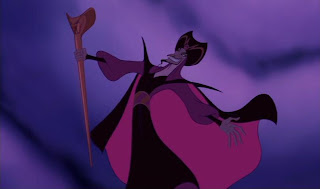In the last post, we talked about how to kill off our villains. However, that doesn't help anything if we don't have a villain to kill off in the first place! Before we begin, though, why do you need a villain at all?
Here's why: every story is only as good as its villain.
The villain is the one who opposes the hero, who prevents him/her from meeting his/her
goals. Without the villain, your story has no conflict—no purpose. Without the
villain, your hero could do and have whatever he wanted, instantly, without any
obstacles. Without a villain, your story would be--prepare yourself!--boring.
Okay, so you need a villain. That still leaves an important question: how does one go about creating a Dark Lord of the Universe? After all, sometimes it can get a little tough to think of a really
evil villain on your own. That’s where this post comes in. I decided to mix
and stir and bake an arch-evil-villain, so that all of you can read my recipe,
be impressed by all the hours I spent slaving over a hot computer, and bake your
own villains.
So, without further ado: a recipe for creating your very own Dark
Lord.
4 cups goal
3 cups motivation
6 tablespoons backstory, sifted
2 handfuls minor villains
1.5 teaspoons weakness
½ cup
accessories
1 pinch gold or lapis lazuli
Preheat the oven to 873 degrees Celsius (1,603.4
Fahrenheit).
In a large black bowl, combine goal, motivation, and
backstory. Blend at light speed for ten minutes, until dough forms blackish
lump. Should have the same consistency throughout
(Note: the villain should want
something—his goal—that is directly opposite what the hero wants. Your villain
must have a good reason for wanting this goal—a motivation. Usually, the
motivation is not isolated in space and time, but is the result of the villain’s
history and upbringing—his backstory. You need all three of these elements to
make the villain believable.)
In a separate, smaller bowl, stir minor villains until
thawed. Then quickly fold into the main batter until completely engulfed.
(Note: minor villains are important
because your hero always, always, always needs opposition. Without opposition,
there’s no suspense or tension or conflict in your story. In other words, it’s
boring. But, hey, your arch-villain can’t be everywhere at once, can he? So
that’s where the minor villains come in. Minor villains provide conflict
against the hero in minor situations. Usually, they’re tied to the main villain
and the main conflict of the story as well.)
Add the weakness and knead carefully, spreading weakness
throughout the whole lump. This is a most delicate phase—too many weaknesses
will make the dough fall apart, but too few will make it dry and fossilized.
(Note: in other words, your villain
can’t be all-powerful. He needs to be relatable, and the way to do this is to
bring in weaknesses. Often, you can find his/her weaknesses if you dig around
enough in the villain’s past.)
Once weaknesses have been kneaded in, sprinkle accessories
on top. This is the point in the recipe where you can add your own distinct
flair: the curling walrus moustache, the pocketwatch that doubles as a sword, the
bright red hair standing on end, or the evil villain cape of awesomeness, for
example.
Bake for 1,095 days in the back burner of your mind. Remove
from oven and let sit. Should be burned black around the edges.
If desired, add a pinch of gold or lapis lazuli for effect. Serve
frozen or boiled in the lava of revenge.
Feeds 1 story.





















